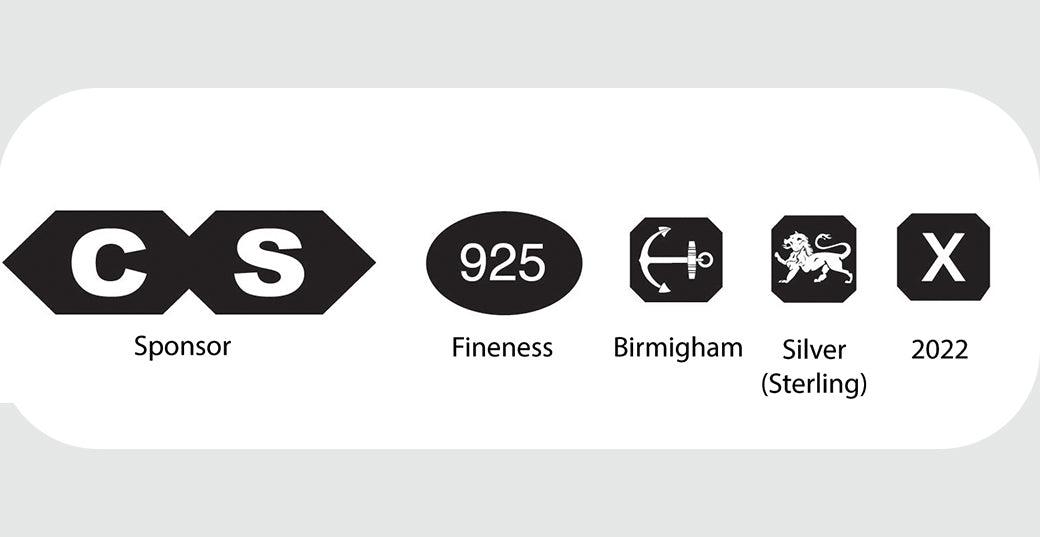A question that we are frequently asked about our pens is what the little marks - known as hallmarks - on any silver or gold parts mean. So we thought it would be helpful to explain the history and development of this important element of British law.
British hallmarks have developed over the course of the last 800 years so that today’s hallmarks provide a comprehensive identifier and consumer guarantee of purity on every item on which they are stamped. For example, here’s what you might find on the cap band or other precious metal part of your Conway Stewart fountain pen today:
Hallmarking was first established in the 12th century and has been used ever since to confirm the quality and purity of precious metals such as gold, silver and platinum. A system of marking such items was necessary because the pure metals are too soft to be used to make jewellery or silverware so they need to be mixed (alloyed) with copper or other metals to give them the strength needed to maintain their shape and durability. This mixing of alloys with precious metal gave unscrupulous manufacturers the opportunity to ‘cheat’ the purchaser by adding more alloy to the mix!
So how did hallmarks become such an essential part of the production of Conway Stewart fountain pens containing silver, gold or platinum components?
More than 800 years ago, in what was probably the earliest form of consumer protection, King John, who reigned in England between 1199 and 1216, decided that precious metals – mostly silver and gold coins at that time – should have a guaranteed and fixed precious metal content. For silver the standard was set at 92.5% with the balance of 7.5% made from copper. Today, this percentage is still confirmed by a Fineness Mark stamped on each piece of sterling silver by the Assay Office which confirms that there are 925 parts per thousand of pure silver.
In 1238, King Henry III proposed that the Guild of Goldsmiths should appoint six of their most worthy goldsmiths to monitor the craft of silver and gold manufacture to try to ensure that the metal content of silver and gold items was being adhered to across the UK.
The Standard or Sterling Mark (Lion Passant)
It was a difficult task which could never be fully policed. However, in 1300 King Edward 1 grasped the nettle and made a law that no gold or silver could be sold until it had been taken to the Guild of Goldsmiths to be tested. If approved, the article would be impressed with a small mark to show that it had been tested and was of the correct quality. The image selected for what was initially known as ‘The King’s Mark’ was that of a lion’s head but it looked more like a leopard so soon became known as the Leopard’s Head mark.
In 1544 the Leopard’s Head mark was superseded by the Lion Passant mark in the form of a lion in full profile, as if walking to the left with its right front paw raised. This mark eventually became known as the Sterling Mark and is used on all sterling silver items today.

The Maker’s Mark
The next step in the regulation of the gold and silver manufacturing processes came in 1363 when King Edward III decided that every goldsmith or silversmith should have a personal ‘mark’ so every piece could be traced back to a specific manufacturer. Many early ‘makers marks’ took note of the fact that very few people at that time could read, so they were designed not as letters but as emblems which could be ‘translated’ into the relevant name. For example, John Rose would have an image of a flower, Tom Farmer would have a sheaf of corn etc. But over the years, as education standards improved, letters became more prevalent as an identifier of the manufacturer so that, for example, ‘CS’ is the current Conway Stewart identifier or maker’s mark.

The Assay Mark
With more and more silver and gold items being manufactured from the 15th century onwards, the testing processes (or assai meaning ‘examination’ in French) was being undertaken in several English cities. Bristol, Birmingham, Chester, Coventry, Exeter, Lincoln, London, Newcastle, Salisbury, Sheffield and York all had their own Assay offices at various times, enabling silversmiths to have their products tested locally.
Today, there are Assay Offices in London (represented by a Leopard Head mark), Birmingham (Anchor), Edinburgh (Castle) and Sheffield (Rose). The Birmingham Assay Office was opened in 1773 and today is one of the busiest Assay Offices in the world.
The majority of Conway Stewart components are assayed at the Birmingham Assay Office.

The Date Mark
The Date Mark was determined as a single alphabetic character for each calendar year with different fonts being used every 20 years or so. In retrospect it would have been much simpler if all Assay Offices had used the same letter and font each year but that wasn’t to be the case, so checking the original manufacturing date of any item of silver can be a lengthy process.
Since 1975, however, all hallmarking date marks have been consolidated, so that all Assay offices use the same date letter which changes on 1st January each year. The last few years have been as follows:

Commemorative marks
Occasionally, special marks may be added to the range of hallmarks found on items of silver or gold. In recent times there have been additional marks to commemorate The Queen’s Silver Jubilee (1977), the Millennium (2000), The Queen’s Golden Jubilee (2002), The Queen’s Diamond Jubilee (2012) and this year The Queen’s Platinum Jubilee. This latest mark may be stamped on any precious metal issued up to the end of 2022. Conway Stewart used this commemorative mark on their Limited Edition pen to celebrate the Queen’s Platinum Jubilee. All 70 of the Sterling Silver pens have been sold. At the time of writing this article we have 3 platinum editions remaining of the Queen’s Platinum Jubilee collection.
Platinum Jubilee Mark for Her Majesty Queen Elizabeth II
Punishable by death
In 1757 counterfeiting hallmarks became a felony, punishable by death. This later changed to transportation to a penal colony. In England it is still a punishable offence (Hallmarking Act 1973) to offer for sale any article purporting to be made of a precious metal unless it bears the official hallmark stamp of one of the recognized Assay Offices. Today, the maximum penalty for counterfeiting a British Hallmark is 10 years imprisonment.
Your guarantee of quality and purity
So those little marks on your Conway Stewart pen and accessories have a lot of history, and give you the assurance that the precious metals used on our pens and accessories are genuine. British hallmarks are a guarantee of quality and purity that’s recognised and valued everywhere around the world.
We hope this has given you an insight into the history and development of British hallmarking and helped you understand what each of the hallmarks on your pens means.



1 comment
Thanks for this blog post that explains British hallmarks. Since I’m from the USA I never knew about this law. That’s an excellent way to ensure quality and purity of precious metals. Too bad we don’t have anything like this in the USA.
Leave a comment